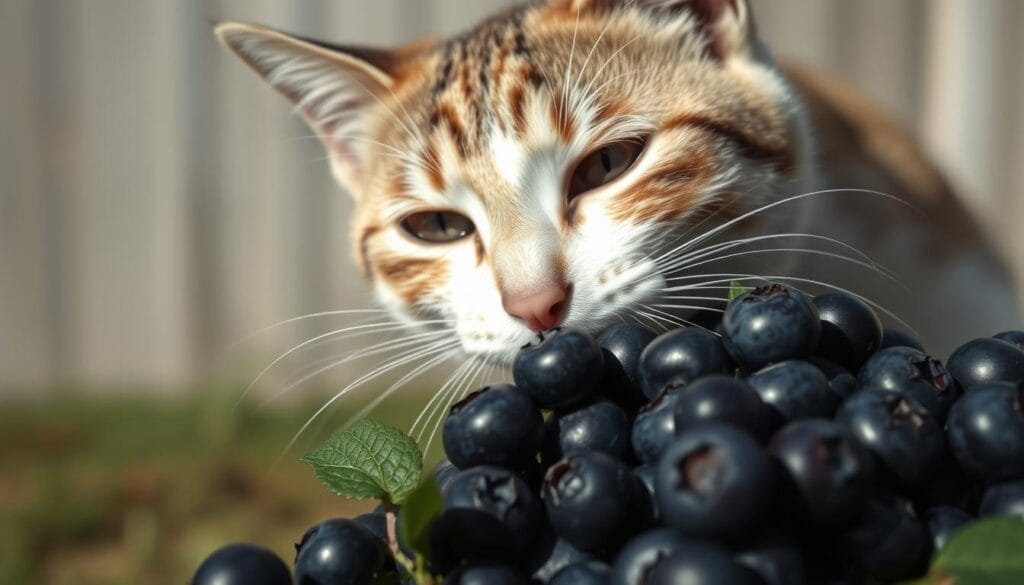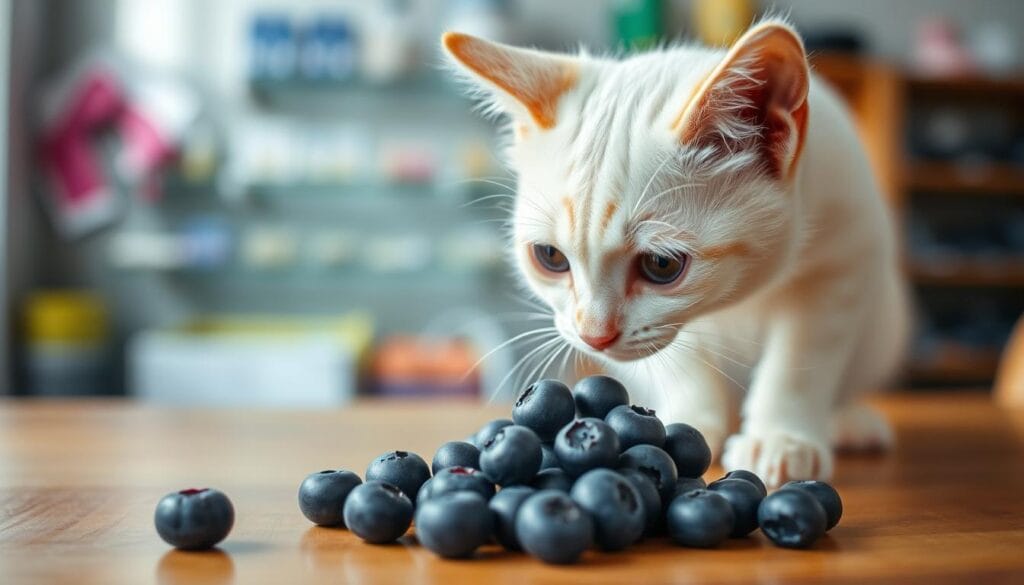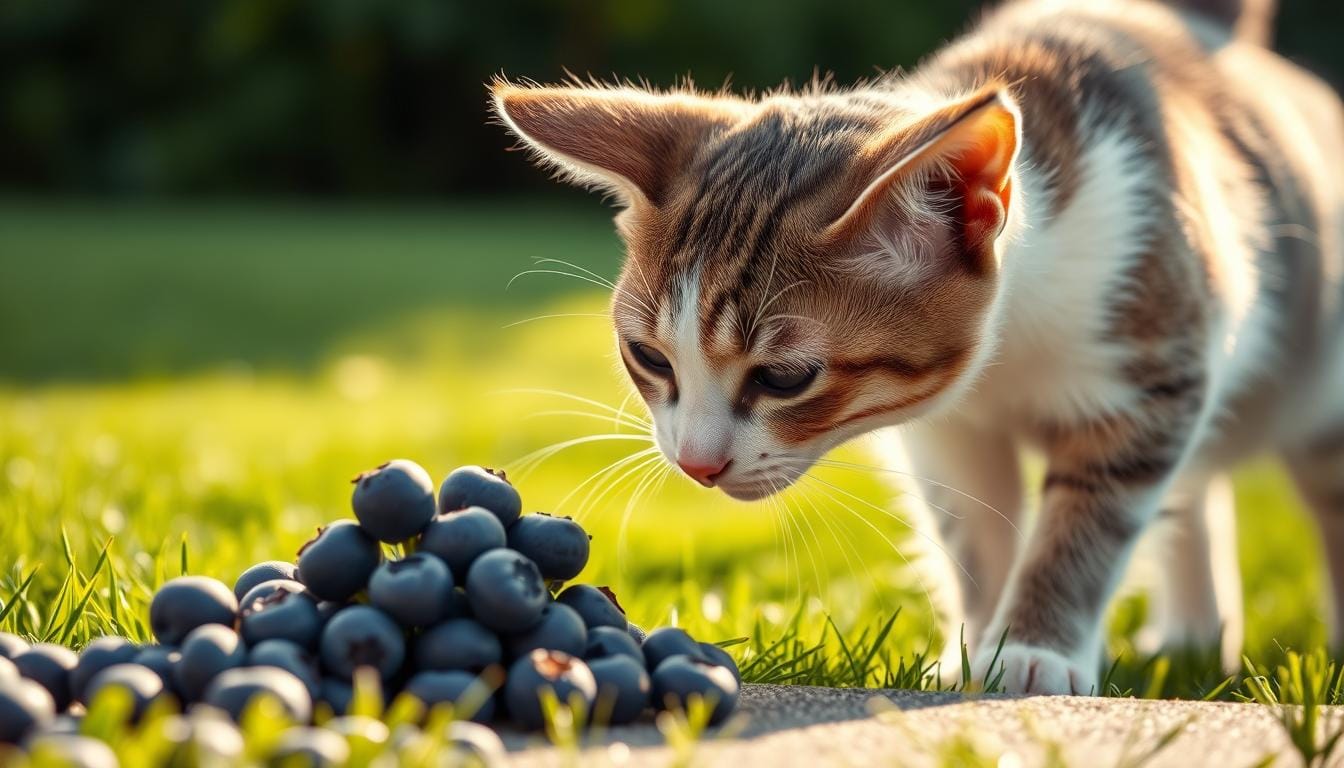Can cats have blueberries? Pros, cons, and preparation methods
can cats have blueberries ?
You’ve likely wondered about sharing your favorite superfoods with your furry companion. Those plump, antioxidant-rich berries in your morning smoothie seem harmless – but what’s safe for humans isn’t always suitable for pets. Before offering that juicy blueberry to your curious feline, pause and consider their unique biology.
Table of Contents
Every pet parent wants the best for their animal companion. Dietary decisions require careful thought, especially since nutritional needs vary between species. While blueberries offer health benefits for people, felines process foods differently due to their carnivorous nature.
This guide addresses critical questions about introducing new foods to your pet’s routine. You’ll learn why veterinary consultation matters before altering meals, particularly for animals with medical histories or special diets. We’ll break down the science behind feline digestion and explore how individual health factors influence food tolerance.
Proper preparation methods and portion control play vital roles in safe treat-sharing practices. Discover how age, existing conditions, and current medications might affect your pet’s ability to process certain fruits. Our research-backed insights help you make informed choices about supplementing your cat’s nutrition while prioritizing their well-being.
Understanding Your Cat’s Natural Diet
Why do felines thrive on meat-based meals while struggling with plant matter? The answer lies in their biological design as obligate carnivores. Their bodies evolved over millennia to prioritize animal proteins for survival.
Obligate Carnivores Explained
These animals require meat to meet critical nutritional needs. Unlike omnivores, they lack specific enzymes to break down plant cellulose efficiently. Taurine and arachidonic acid – essential nutrients found only in animal tissues – must come from their meals.
Digestive Limitations with Fruits
Feline digestive systems process vegetation differently than herbivores. Their short intestinal tracts quickly metabolize proteins but struggle with fibrous materials. Limited amylase production makes carbohydrate digestion challenging, even in small quantities.
| Trait | Carnivores | Herbivores |
|---|---|---|
| Digestive Tract Length | 3-4 times body length | 10-12 times body length |
| Primary Enzymes | Proteases | Cellulases |
| Fiber Processing | Low efficiency | High efficiency |
This biological framework explains why plant-based foods shouldn’t dominate your pet’s nutrition. While occasional fruit treats might be tolerated, meat remains the cornerstone of healthy feline diets.
Can Cats Have Blueberries?
While pet owners often consider sharing nutrient-packed snacks with their companions, safety remains paramount. Fresh or frozen berries pose minimal risks when served occasionally and in moderation. Always prioritize organic options to reduce exposure to harmful chemicals.

Assessing Safety for Your Feline Friend
Processed fruit products containing added sugars or preservatives should never reach your pet’s bowl. Jams, pies, and sweetened compotes often include ingredients that disrupt digestive systems. Stick to raw or thawed versions without additives.
Introduce new foods slowly over several days. Watch for unusual behaviors like vomiting or lethargy. Diabetic animals require special consideration due to natural fruit sugars – consult your veterinarian first.
| Safe Options | Unsafe Choices |
|---|---|
| Fresh organic berries | Canned pie fillings |
| Frozen (thawed) | Jams/jellies |
| Mashed pulp | Sweetened dried varieties |
Most healthy pets tolerate small portions well, but individual reactions vary. Keep treats under 10% of daily caloric intake. Those with chronic conditions need personalized feeding plans from animal nutrition experts.
Nutritional Benefits of Blueberries for Cats
Beyond their sweet taste, blueberries offer compounds beneficial to animal health. These small fruits contain essential nutrients that may complement your pet’s diet when served responsibly. While not a dietary necessity, they provide valuable phytochemicals absent in most commercial cat foods.
Antioxidant and Immune Support
Blueberries rank among nature’s richest antioxidant sources. Compounds like anthocyanins combat free radicals, protecting cells from oxidative damage. This cellular defense supports overall wellness and may reduce inflammation-related discomfort.
Vitamins C and E strengthen immune responses by enhancing white blood cell efficiency. Manganese aids enzyme production, while potassium maintains proper nerve and muscle function. These elements work synergistically to promote vitality.
Fiber Benefits for Digestion
The fruit’s fiber content assists digestive processes by regulating bowel movements. Soluble fiber acts as a prebiotic, feeding beneficial gut bacteria. This promotes nutrient absorption and helps prevent constipation in sensitive pets.
Moderate fiber intake supports healthy weight management by creating a feeling of fullness. Always balance fruit treats with high-protein meals to respect your pet’s carnivorous needs.
| Nutrient | Benefit | Key Role |
|---|---|---|
| Vitamin C | Immune support | Enhances white blood cell function |
| Dietary Fiber | Digestive health | Promotes regular bowel movements |
| Manganese | Metabolic processes | Supports enzyme activity |
Remember: These berries should never replace meat-based nutrition. Consult your veterinarian to determine appropriate serving sizes based on your pet’s specific health profile.
Potential Risks of Feeding Blueberries to Your Cat
Treats might seem harmless, but even nutritious foods carry hidden dangers for pets. Felines process sugars and fiber differently than humans, making moderation critical. Understanding these risks helps prevent health complications while allowing occasional indulgences.

Blood Sugar Spikes and Weight Gain
Though small, blueberries contain natural sugars that affect metabolism. Pets with diabetes face particular risks – even minor glucose fluctuations can worsen their condition. Regular overfeeding may lead to obesity due to excess calorie intake.
Digestive Challenges and Choking Hazards
Introducing new foods too quickly often causes stomach discomfort. Sensitive pets might experience diarrhea or vomiting from fiber overload. Whole berries pose airway obstruction risks for kittens and smaller breeds.
| Risk Factor | Common Symptoms | Prevention Tips |
|---|---|---|
| High Sugar Content | Lethargy, increased thirst | Limit to 1-2 berries weekly |
| Fiber Overload | Diarrhea, vomiting | Mash before serving |
| Choking Hazard | Coughing, gagging | Cut into quarters |
Always monitor your pet after introducing new treats. Consult your veterinarian if unusual behaviors persist. Balance fruit snacks with protein-rich meals to maintain nutritional harmony.
Portion Control and Frequency Guidelines
Moderation proves crucial when introducing novel foods to obligate carnivores. Treats like berries should never exceed 10% of daily calories, with the remaining 90% coming from vet-approved meals. This balance prevents nutritional imbalances while allowing safe exploration of new flavors.
Start with one berry to observe reactions. Wait 24 hours before offering another. Most pets handle 1-3 pieces weekly without issues, but individual tolerance varies. Smaller breeds or senior animals may need reduced portions.
| Cat Size | Max Per Serving | Weekly Frequency | Preparation Tip |
|---|---|---|---|
| Under 8 lbs | 1 berry | Once | Mash thoroughly |
| 8-12 lbs | 2 berries | Twice | Quarter pieces |
| Over 12 lbs | 3 berries | Twice | Remove stems |
Dr. Deborah Bayazit recommends limiting fruit snacks to 1-2 weekly sessions. Track all treats given throughout the day – including dental chews or fish flakes – to stay within safe limits. Adjust servings if your pet shows signs of stomach discomfort or weight changes.
Always prioritize protein-rich meals over plant-based options. Consult your veterinarian to create personalized feeding plans for pets with diabetes or digestive sensitivities. Proper portioning ensures treats remain enjoyable without compromising health.
How to Prepare Blueberries Safely for Cats
Serving fresh treats requires careful handling to ensure pet safety. Proper techniques eliminate risks while preserving nutritional value. Follow these steps to transform berries into feline-friendly snacks.
Washing and Quality Checks
Always choose organic produce to avoid pesticide residues. Rinse berries under cool running water for 30 seconds, gently rubbing surfaces. Discard any with soft spots or mold growth – these can cause stomach upset.
Chopping and Mashing
Cut berries into pea-sized pieces to prevent choking hazards. For kittens or seniors, mash thoroughly into a pulp. Remove stems and leaves before serving – these parts offer no benefits and may irritate digestive systems.
Store prepared portions in airtight containers for up to three days. Never substitute fresh fruit with processed alternatives like juices or syrups. Always consult your veterinarian about dietary adjustments, especially for pets with health conditions.
- Can Cats Eat Oranges? The Surprising Truth
- Can Cats Eat Blueberries? Benefits and Risks Explained
- Can Cats Eat Grapes? Vet Answers and Safe Alternatives
- Can Cats Eat Mango? What Every Cat Owner Should Know
- Can Cats Eat Pineapple? Safety Tips for Cat Owners

